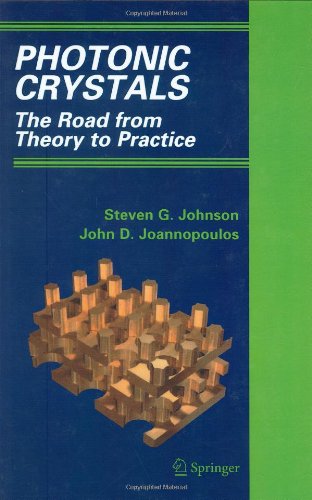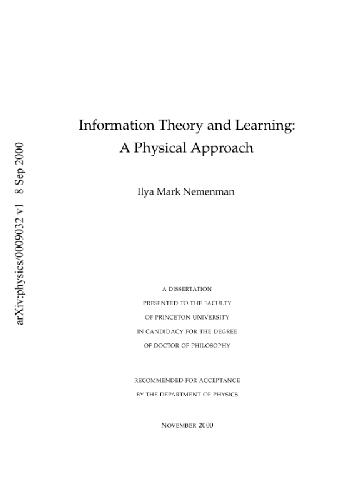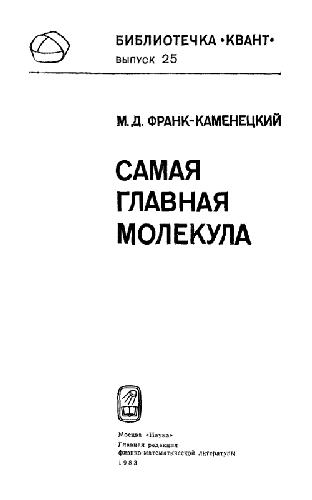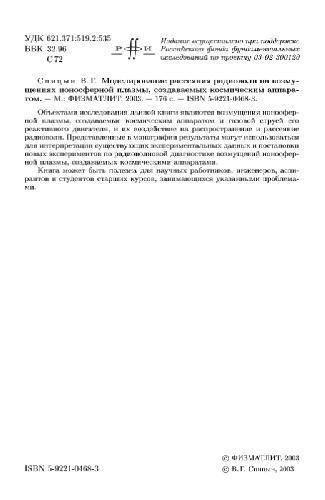Esteban A. Calzetta, Bei-Lok B. Hu0521641683, 9780521641685, 9780511424328
Table of contents :
Cover……Page 1
Half-title……Page 3
Series-title……Page 4
Title……Page 7
Copyright……Page 8
Dedication……Page 9
Contents……Page 11
Preface……Page 15
Part I: Fundamentals of nonequilibrium statistical mechanics……Page 19
1 Basic issues in nonequilibrium statistical mechanics……Page 21
1.1 Macroscopic description of physical processes……Page 22
1.2.1 Ergodicity describes a system in equilibrium……Page 29
1.2.2 Mixing system is time-reversible; weak sense of approach to equilibrium……Page 30
1.2.3 Dissipative system: coarse-grained mixing permits approach to equilibrium……Page 31
1.2.4 Nonequilibrium thermodynamics and chaotic dynamics……Page 33
1.3 Physical conditions……Page 34
1.3.1 Large systems: Fluctuations, Poincaré recurrence and thermodynamic limit……Page 35
1.3.2 Initial conditions: Specific, randomized, dynamical correlations……Page 36
1.3.3 Time-scales and interaction……Page 37
1.3.4 Coarse graining……Page 38
1.4 Coarse graining and persistent structure……Page 39
1.5.1 Open systems: Coarse graining and back-reaction……Page 44
1.5.3 Two major paradigms of nonequilibrium statistical mechanics……Page 47
1.6.1 Probability, random variables and stochastic processes……Page 49
1.6.2 Markov processes……Page 53
1.6.3 Kramers–Moyal and Fokker–Planck equations……Page 55
2.1 A simple model of Brownian motion……Page 57
2.1.1 The linear oscillator model……Page 58
2.1.2 Fluctuation–dissipation theorem……Page 61
2.2 The Fokker–Planck and Kramers–Moyal equations……Page 63
2.3 The Boltzmann equation……Page 67
2.3.1 Slaving of higher correlations in the Boltzmann equation……Page 70
2.3.2 Corrections from quantum statistics……Page 72
2.3.3 Relativistic kinetic theory……Page 73
2.3.4 Fluctuations in the Boltzmann equation……Page 75
3.1 A quick review of quantum mechanics……Page 78
3.1.1 Wigner functions……Page 80
3.1.2 Closed time path (CTP) integrals……Page 84
3.2 Influence functional……Page 86
3.2.1 Some properties of the influence action……Page 88
3.2.2 The linear bath model……Page 89
3.3 The master equation……Page 90
3.4 The Langevin equation……Page 91
3.4.1 The linear bath model……Page 95
3.5 The Kramers–Moyal equation……Page 97
3.5.1 The linear system model……Page 99
3.6 Derivation of the propagator and the master equation……Page 100
3.6.1 Evolution of the reduced density matrix……Page 101
3.6.2 Master equation……Page 102
3.7 Consistent histories and decoherence functional……Page 104
Part II: Basics of nonequilibrium quantum field theory……Page 109
4 Quantum fields on time-dependent backgrounds: Particle creation……Page 111
4.1.1 Classical fields……Page 112
4.1.3 Free fields……Page 114
4.1.4 Particle creation……Page 116
4.1.5 Adiabatic vacua……Page 118
4.1.6 Hamiltonian mean field dynamics and general Gaussian ansatz……Page 121
4.2 Particle production in external fields……Page 124
4.2.1 Particle creation in a constant electric field……Page 126
4.3 Spontaneous and stimulated production……Page 129
4.3.1 Spontaneous production……Page 130
4.3.2 Stimulated production……Page 131
4.4.1 Adiabatic number state……Page 132
4.4.2 Number and correlation……Page 133
4.4.3 Current and energy density……Page 134
4.4.4 Quantum Vlasov equation……Page 135
4.5 Periodically driven fields……Page 136
4.5.1 Broad resonance……Page 137
4.5.2 Narrow resonance……Page 138
4.6 Particle creation in a dynamical spacetime……Page 139
4.6.1 Wave equations in curved spacetimes……Page 140
4.6.2 Conformal vacuum in conformally-static spacetimes……Page 142
4.6.3 Thermal radiance……Page 143
4.6.4 Conformal stress–energy tensor……Page 144
4.6.5 Adiabatic regularization……Page 145
4.6.6 A simple model of a cosmological phase transition……Page 147
4.7 Particle creation as squeezing……Page 149
4.7.1 Evolutionary operator, squeezing and rotation……Page 150
4.7.2 Dynamics of the squeezing parameters……Page 154
4.7.3 Number, coherence and initial states……Page 156
4.7.4 Fluctuations in number……Page 159
4.8.1 Dissipation and noise kernels……Page 161
4.8.2 u1 … v2 functions……Page 163
4.8.3 a11 … b4 functions……Page 164
5 Open systems of interacting quantum fields……Page 166
5.1 Influence functional……Page 167
5.1.1 Perturbation theory……Page 169
5.1.2 Noise and fluctuations……Page 174
5.1.3 Langevin equation and fluctuation–dissipation relation……Page 175
5.2 Quantum functional master equation……Page 176
5.3 The closed time path coarse-grained effective action……Page 180
5.3.1 Stochastic equations……Page 184
6 Functional methods in nonequilibrium QFT……Page 188
6.1 Propagators……Page 189
6.1.1 Interacting fields……Page 191
6.2 Functional methods……Page 192
6.2.1 The generating functional and the effective action……Page 194
6.2.3 Trouble in the … theory……Page 195
6.3 The closed time path effective action……Page 198
6.3.1 An example……Page 200
6.3.2 The structure of the closed time path effective action……Page 203
6.4.1 The background field method……Page 205
6.4.2 The loop expansion……Page 207
6.4.3 The one-loop closed time path effective action for the … theory……Page 208
6.4.4 The large N expansion……Page 211
6.5 The two-particle irreducible effective action……Page 213
6.5.1 The 2PI effective action in the … theory……Page 217
6.5.2 Large N expansion (suite)……Page 218
6.6.1 Ultraviolet divergences……Page 221
6.6.2 Initial time singularities……Page 224
6.6.3 Other divergences……Page 225
Part III: Gauge invariance, dissipation, entropy, noise and decoherence……Page 227
7 Closed time path effective action for gauge theories……Page 229
7.1.1 Gauge theories……Page 232
7.1.2 Gauge symmetries and constraints……Page 233
7.1.3 The measure of integration……Page 234
7.1.4 BRST invariance……Page 236
7.1.5 Physical states……Page 238
7.1.6 Initial conditions for nonvacuum states……Page 239
7.2.1 The 2PI effective action……Page 241
7.2.2 The 2PI Schwinger–Dyson equations……Page 242
7.2.3 The reduced 2PI effective action……Page 243
7.3.1 The Zinn-Justin equation……Page 244
7.3.2 Gauge dependence of the propagators……Page 246
7.3.3 Transverse and longitudinal gluon propagators……Page 248
8 Dissipation and noise in mean field dynamics……Page 249
8.1 Preliminaries……Page 252
8.2 Dissipation in the mean field dynamics……Page 253
8.3 Dissipation and particle creation……Page 254
8.4 Particle creation and noise……Page 256
8.5 Full quantum correlations from the Langevin approach……Page 258
8.6 The fluctuation–dissipation theorem……Page 260
8.7 Particle creation and decoherence……Page 261
8.8 The nonlinear regime……Page 262
8.9 Final remarks……Page 267
9.1 Entropy generation from particle creation……Page 269
9.1.1 Choice of representations and initial conditions……Page 270
9.1.3 Differences in various definitions of entropy……Page 271
9.2 Entropy of quantum fields……Page 273
9.2.1 Entropy special to choice of representation and initial conditions……Page 274
9.2.3 Entropy from slaving of higher correlations……Page 275
9.3 Entropy from the (apparent) damping of the mean field……Page 276
9.3.1 Time-scales……Page 277
9.3.2 Density matrix……Page 278
9.3.3 Entropy generation……Page 279
9.4 Entropy of squeezed quantum open systems……Page 280
9.4.1 Entropy from the evolutionary operator for reduced density matrix……Page 281
9.4.2 Measures of fluctuations and coherence……Page 282
9.4.3 Entropy and uncertainty functions of an inverted oscillator……Page 283
9.4.4 Entropy from graviton production in de Sitter spacetime……Page 285
9.4.5 Discussion……Page 287
9.5 Decoherence in a quantum phase transition……Page 288
9.6 Spinodal decomposition of an interacting quantum field……Page 292
9.6.1 The quench transition time……Page 294
9.6.2 Decoherence time……Page 296
9.7 Decoherence of the inflaton field……Page 299
9.7.1 Noise from interacting quantum fields……Page 300
9.7.2 Decoherence in two interacting fields model……Page 301
9.7.3 Partitioning one interacting field: noise from high frequency modes……Page 304
Part IV: Thermal, kinetic and hydrodynamic regimes……Page 307
10.1 The thermal generating functional……Page 309
10.2 Linear response theory……Page 311
10.3 The Kubo–Martin–Schwinger theorem……Page 312
10.4 Thermal self-energy: Screening……Page 315
10.5 Landau damping……Page 316
10.5.1 Landau damping in a relativistic collisionless plasma……Page 317
10.5.2 A nonequilibrium problem with fermions: The case of QED……Page 318
10.5.4 Induced charge density from a finite temperature Dirac quantum field……Page 321
10.6.1 The model……Page 323
10.6.2 Hard thermal loops……Page 324
10.6.3 Hard thermal loops from the 2PI CTP effective action……Page 325
10.6.4 The Vlasov equation for hard modes……Page 326
10.6.5 Ultrasoft modes and Boltzmann equation……Page 328
10.6.6 Langevin dynamics of ultrasoft modes……Page 330
10.6.7 A note on the literature……Page 332
11.1.1 The model……Page 333
11.1.2 Density of states and distribution function……Page 335
11.1.3 The dissipation and noise kernels……Page 336
11.1.4 The retarded and advanced propagators……Page 338
11.1.5 The off-shell kinetic equation……Page 340
11.1.6 Weakly coupled theories and the Boltzmann equation……Page 341
11.1.7 The Vlasov equation……Page 344
11.1.8 Time reversal invariance……Page 346
11.1.9 The limits of the kinetic approach……Page 347
11.2.1 The scalar Wigner function in scalar quantum electrodynamics (SQED)……Page 348
11.2.2 Scalar Wigner functions on non-abelian backgrounds……Page 352
11.2.3 Quantum kinetic theory in curved spacetimes……Page 356
11.2.4 A note on the literature……Page 361
12 Hydrodynamics and thermalization……Page 363
12.1.2 Covariant hydrostatics……Page 364
12.1.3 Ideal and real fluids……Page 367
12.1.4 Stability and the Landau–Lifshitz theory……Page 370
12.2.1 Quantum hydrodynamic models……Page 371
12.2.2 Thermal equilibrium states……Page 374
12.2.3 Local equilibria……Page 376
12.3 Transport functions in the hydrodynamic limit……Page 378
12.3.1 The collision term……Page 379
12.3.2 The linearized transport equation……Page 380
12.3.3 The temperature shift and the bulk stress……Page 381
12.3.4 Shear stress and bulk viscosity……Page 382
12.3.5 Transport functions for non-abelian plasmas……Page 383
12.4.1 The spin diffusion coefficient……Page 385
12.4.2 The bulk and shear viscosity coefficients……Page 388
12.5 Thermalization……Page 392
12.5.1 A toy model of thermalization……Page 393
12.5.2 Thermalization of isolated fields……Page 396
12.5.3 The stages of thermalization……Page 399
12.5.4 Coda……Page 405
Part V: Applications to selected current research……Page 407
13 Nonequilibrium Bose–Einstein condensates……Page 409
13.1 The closed time path integral approach to BECs……Page 411
13.1.1 The coherent state representation……Page 412
13.2 The symmetry-breaking approach to BECs……Page 414
13.2.1 A relationship between A and AB……Page 418
13.2.2 Gaplessness and phase invariance……Page 419
13.2.3 Conserving and -derivable theories……Page 420
13.2.4 The full 2PI effective action as a -derivable approach……Page 422
13.2.5 Varieties of theories from truncations of the 2PI effective action……Page 423
13.2.6 Higher gapless approximations……Page 428
13.2.7 Damping……Page 430
13.2.8 The stochastic Gross–Pitaevskii equation……Page 433
13.2.9 The hydrodynamic and quantum kinetic approach to BECs……Page 435
13.3 The particle number conserving formalism……Page 438
13.3.1 Problems with the symmetry-breaking approach……Page 439
13.3.2 The one-body density matrix and long-range coherence……Page 440
13.3.3 The particle number conserving approach……Page 441
13.3.4 Particle number conserving functional approach……Page 444
14.1.1 In the beginning……Page 447
14.1.2 The Bjorken scenario……Page 448
14.1.3 Break-up……Page 450
14.1.4 Measuring the fireball……Page 452
14.1.5 Insights from nonequilibrium quantum field theory……Page 455
14.2 Disoriented chiral condensates (DCCs)……Page 457
14.2.1 Self-consistent mean fields in the large N approximation……Page 459
14.2.2 The quantum pion field……Page 461
14.2.3 Adiabatic modes and renormalization……Page 462
15 Nonequilibrium quantum processes in the early universe……Page 465
15.1.1 Inflationary cosmology……Page 466
15.1.2 Noise in stochastic inflation……Page 470
15.2 Structure formation: Effect of colored noise……Page 475
15.2.1 Colored noise from smooth window functions……Page 477
15.2.2 Curvature perturbations and blue tilt……Page 481
15.2.3 Structures from coarse graining an interacting field……Page 483
15.2.4 Structures from interaction with other fields……Page 484
15.2.5 Primordial spectrum from nonequilibrium renormalization group……Page 488
15.3 Reheating in the inflationary universe……Page 492
15.3.1 Case study I: Back-reaction of Fermi fields during preheating……Page 493
15.3.2 Case study II: Primordial magnetic field generation……Page 500
References……Page 508
Index……Page 548







Reviews
There are no reviews yet.